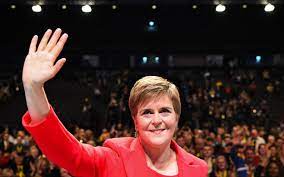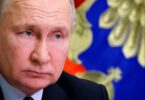Tom Harris
The dream of Scottish independence may still be alive among a minority of Scots, but the political vehicle on which nationalists relied to achieve that dream has crashed in spectacular fashion. With the arrest of Nicola Sturgeon – an embarrassing spectacle, although she has since been released without charge pending further investigations – the SNP finds itself in deep political trouble.
It will struggle to move forward until this investigation concludes, at the very least. After all, Mrs Sturgeon’s arrest is the third high-profile one, following that of her husband, the SNP’s former chief executive Peter Murrell, and former party treasurer Colin Beattie, both of whom were released without charge pending further investigation. Yet it is Sturgeon’s fall from grace that is most spectacular. She was one of Scotland’s – and Britain’s – most successful politicians, helping to lay the groundwork for the nationalist domination of Scottish politics, and then maintaining it as first minister for an extraordinary eight years.
Her tenure was defined by an uninterrupted series of electoral triumphs at local, Scottish and UK level – but it was a record balanced by an equally notable lack of achievement on the policy front. When she left office, her devolved administration was struggling with the same problems that existed when she took office in November 2014: a wide and damaging attainment gap between wealthy and poorer pupils in Scottish schools, historically long waiting times for vital operations, and a sclerotic Scottish economy. When she finally threw in the towel, during a hastily-arranged and unexpected press conference in February, she left behind a party in tatters. Even before Sturgeon became a member of the Scottish Parliament in 1999, she was already a recognised face in the small world of Scottish politics. After standing unsuccessfully for a number of local council and Westminster seats (in 1992 she became the youngest ever general election candidate when she represented the SNP in the Shettleston constituency), she was finally elected to Holyrood in the first devolved elections in 1999. From this point, she was regarded as leadership material and formed a close personal and political bond with Alex Salmond during his first stint as SNP leader. Sturgeon’s own personal manner and styling changed noticeably once she became an MSP. She smiled more and adopted a less severe countenance – at least publicly. Slowly she managed to shed the “Nippy Sweetie” nickname her enemies had bestowed on her. When Salmond returned from his self-imposed exile at Westminster to resume the role of party leader in 2004, Sturgeon stood as his deputy and won. The succession was already being planned for. But her period as Scotland’s health minister from 2007 to 2012 stubbornly refused to produce any notable achievements. Nevertheless, her stock among party activists – and ordinary Scottish voters – continued to rise, and when Salmond resigned in the aftermath of defeat in the 2014 Scottish independence referendum, there was only one realistic candidate to whom the torch could be passed.
Within months of taking up residence at Bute House, the official residence of Scotland’s first minister, Sturgeon fronted the SNP’s general election campaign, leading her party to an unprecedented victory, winning 56 of Scotland’s 59 Westminster seats and reducing its traditional opponents, Scottish Labour, to a single seat. A year later, with the UK narrowly voting Leave while Scotland voted by a three-to-two margin to Remain, Sturgeon was handed the perfect opportunity to agitate for the second referendum that she was always going to demand – even if, until then, she was having difficulty choosing the best excuse. She immediately became the hero of disappointed Remainers across the UK who chose to ignore the fact that she had just spent two years campaigning for Scotland to leave not only the UK but the EU as well. In hindsight, this proved the apex of Sturgeon’s influence. First, successive prime ministers, from Theresa May to Rishi Sunak, refused to accede to her demands for a second vote. At the same time, Sturgeon’s leadership was disturbed by the legal battles of her predecessor, Salmond, who had found himself in court facing a series of charges based on complaints of sexual misconduct. Salmond was acquitted but Sturgeon, having taken the side of the female complainants, became an object of loathing for Salmond and his supporters. This was personal. Yet the dramatic events seemed to have little impact on Scots’ willingness to vote for her party, and her reputation was further enhanced during the Covid pandemic when she chose to appear on live TV broadcasts delivering updates to the public as the lockdowns were enacted and the vaccine rolled out.
Frustrated with her own inability to act on her repeated commitment to a second referendum, she was persuaded to request a definitive ruling from the UK Supreme Court on whether the approval of the UK government was strictly necessary for the Scottish Parliament to organise a second vote. Their Lordships’ verdict was unequivocal: it was. With troubles mounting around her – unbuilt ferries in Port Glasgow, lengthening waiting lists in the NHS, her own activists’ increasingly voluble impatience for a referendum and an unexpected (and popular) veto by the UK government of her gender ID legislation for trans people – Sturgeon vanished from the political scene. The irony is that it is what happened afterwards – the dramatic arrest of her husband days after leaving office – that will define her in the history books. Can she rebound? Rumours that she might accept a high-profile international post with the UN or an NGO will have abated during the recent dramatic developments. Much will depend on whether she faces charges and a court appearance. But either way, events have placed a gloomy shadow over her reputation. This is the woman who was once assumed to be destined to lead Scotland into a new era as an independent country.
The Telegraph







